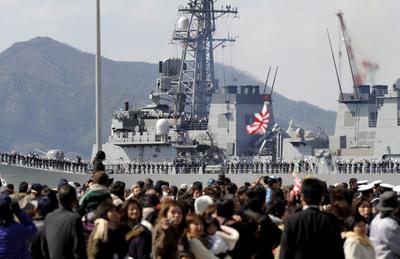This concept espouses the flexible and effective use of Japan’s Self-Defense Forces (SDF) against various unspecified ‘contingencies’ — which are generally understood to be China and North Korea. A more dynamic defence force would also entail a review of present SDF deployments and seek to strengthen defence cooperation with the US.
Three points in particular can be noted about China in Japan’s new defence white paper. First, in line with the 2011 white paper, the 2012 version promotes the dynamic defence force concept and the flexible deployment of the SDF to Japan’s southwest island chain, including Okinawa and the Senkaku/Diaoyu islands. Moving from the long-esteemed concept of a basic defence force, the 2010 NDPG introduced the dynamic defence concept. This was a product of compromise between the necessity of coping with new security challenges and a limited budget. The application of this new concept to Japan’s southwest island chain is clearly intended to counter China’s maritime challenge. Yet the 2012 white paper pushes the concept even further and, in a new section called ‘dynamic defence cooperation’, it hints at the link between the implementation of the concept and recent developments in US–Japan defence cooperation.
Second, the 2012 white paper has become more forceful in its description of China’s maritime activities around the Senkaku/Diaoyu islands. And in line with the 2011 paper, it also dares to include the emotional word kouatsuteki (pressing from a superior position) in the original Japanese version to refer to Chinese maritime activities in the South China Sea. In the English version, kouatsuteki is translated only as ‘assertive’, but the nuance in the Japanese language is stronger. The inclusion of this kind of emotional word had not been found in a white paper before 2011.
Third, while the description of China’s military policy and activities is written in a constrained way, the 2012 white paper includes for the first time a reference to the sensitive relationship between the People’s Liberation Army (PLA) and the Chinese Communist Party (CCP) in China’s defence policy making. This reference is limited, however. The white paper simply introduces the conventional observation shared between many Western analysts: it states in the main text that ‘some see that relations between the CCP leadership and the People’s Liberation Army (PLA) has [sic] been getting complex and others see that the degree of military influence on foreign policy decisions has been changing’. It adds that, ‘in order to allay other countries’ concerns over China, it is becoming more and more important for China itself to improve transparency’.
China’s reaction to the 2012 white paper was rather prompt and emotional. The Chinese Ministry of Defence denounced Japan’s reference to the relationship between the PLA and the CCP as ‘irresponsible remarks regarding China’s internal affairs’, and it stated that it ‘strongly opposes the groundless criticisms’. China’s response may be partly ascribed to domestic politics, such as the coming reshuffle of the CCP leadership. It may also be a reaction to incorrect reports surrounding the white paper during its early stages, or to the increasingly militarised nature of Japan’s response to China — and Japan’s alliance with the US. However, the inclusion of the PLA–CCP relationship and the use of emotional wording in the paper may have played a larger part in China’s reaction.
This development could have serious implications for Japan’s bilateral relations with China. According to the 1972 Japan–China Joint Communiqué, reached between the two countries when relations were normalised, Japan agreed not to interfere in China’s domestic affairs. Under this agreement, Japan was to avoid direct references to Chinese domestic politics and emotional language in relation to China. Defence white papers in the past have followed this line, and the two countries have long maintained a political consensus not to escalate political and security disputes. But the 2012 white paper may have sent a signal that Japan no longer cares to maintain the post-1972 political consensus — even in an official defence document.
The 2012 white paper alone will not change the bilateral relationship immediately, but leaving behind the post-1972 consensus may have an impact in the long term. Though it is still full of reserved language to avoid provoking China, the 2012 version does reflect underlying Japanese dissatisfaction or ‘irritation’ over China’s recent maritime assertiveness in the South China Sea and the East China Sea. In the Japanese bureaucratic system, the use of language is traditionally very constrained. Changes in description and the use of emotional words are rare in a Japanese defence white paper. In this sense, the 2012 white paper may indicate a new trend in Japan’s defence policy in relation to China.
Toshiya Takahashi is a PhD candidate at the National Security College, the Australian National University.


It’s interesting to see how Japanese observers refer to recent activities around the Senkaku/Daoyu Islands as “Japanese dissatisfaction” or “irritation” over China’s recent maritime “assertiveness”, yet ignore similar action from Taiwan, and ignore Chinese ‘irritation” over recent US & Japanese references to the US-Japan Security Treaty including the islands, the Tokyo Governor’s statements about “purchase” of the islands, and Japanese private landings on the islands. The change in language is worth noting, but it would also be worth examining the implications for Chinese policy towards Japan of an increasing Japanese assertiveness in regard to territorial claims over the Senkakus.
This report ignores the dissatisfaction of South Korea over Japan’s assertiveness against the rocky Dokdo islets in South Korea.
And now there is a 37 day US-Japan drill on Tinian Island off the coast of the Northern Marianas simulating the taking-back of an enemy (read China) occupied island.
You can only prod a tiger so many times before it turns and bites your hand off.